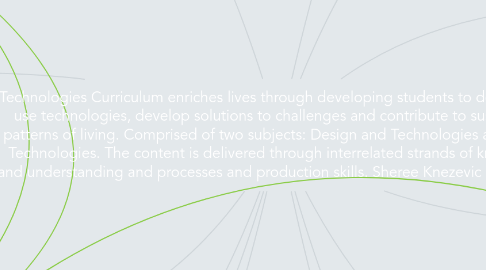
1. Aim: Technologies
1.1. Develop knowledge, understanding and skills to enable students:
1.1.1. Aim: Design and Technologies
1.1.1.1. Design and Technologies aim to develop the knowledge, understandings and skills to ensure students:
1.1.1.1.1. Understand the roles and responsibilities of people in design and technologies occupations and how they contribute to society.
1.1.1.1.2. Produce designed solutions suitable for a range of Technologies contexts by selecting and manipulating a range of materials, systems, components, tools and equipment creatively, competently and safely and managing processes.
1.1.2. Investigate, design, plan, manage, create and evaluate solutions.
1.1.3. Become creative, innovative and enterprising when using traditional, contemporary and emerging technologies, and understand how technologies have developed over time.
1.1.4. Make informed and ethical decisions about the role, impact and use of technologies in the economy, environment and society for a sustainable future.
1.1.5. Engage confidently with and responsibly select manipulate appropriate technologies - materials, data, systems, components, tools and equipment when designing and creating solutions.
1.1.6. Digital Technologies
1.1.6.1. Digital technologies aims to develop the knowledge, understanding and skills to ensure the students:
1.1.6.1.1. Use computational thinking and the key concepts of abstraction; data collection, representation and interpretation; specification, algorithms and implementation to create digital solutions.
1.1.6.1.2. Confidently use digital systems to efficiently and effectively transform data into information and to creatively communicate ideas in a range of settings.
1.1.6.1.3. Apply systems thinking to monitor, analyse, predict and shape the interactions within the between information systems and understand the impact of these systems on individuals, societies, economies and environments.
2. Links to other learning areas
2.1. English
2.1.1. Accurate and clear communication through describing objects and events.
2.2. Mathematics
2.2.1. Students process data, develop metric units and use a vast range of scales.
2.3. Science
2.3.1. Concepts from biological, chemical and physical sciences to solve problems and design solutions.
2.4. The Arts
2.5. Geography
2.5.1. In the early years students develop spatial understanding as they create, interpret and use maps. Students progress into studying environmental characteristics of places, processes and human significance.
2.6. Health and Physical Education.
2.7. History
2.7.1. Technology development are a source of historical facts and artefacts. Has developed through gradual accumulation of knowledge over many centuries.
3. Differences between ACARA and SCSA
3.1. Band Level Description for ACARA
3.1.1. The Technologies subject is written in bands of year levels. Each band level provides an overview of the content at each level and emphasise the interrelated nature of the two strands and the expectation that planning will involve integration of content from across the strands
3.1.1.1. Foundation to Year 2
3.1.1.2. Years 3 and 4
3.1.1.3. Years 5 and 6
3.1.1.4. Years 7 and 8
3.1.1.5. Years 9 and 10
3.2. Band Level Description for SCSA
3.2.1. SCSA
3.2.1.1. Individual year descriptors up to year 10
3.2.1.2. SCSA address generating and designing (F-4) and producing and implementing (F-2) under the Digital Technologies - processes and production skills were ACARA do not address this for this year group.
4. Two Related Strands
4.1. Knowledge and understanding
4.2. Processes and production skills
5. Cross Curriculum Priorities
5.1. Aboriginal and Torres Strait Islander histories and cultures
5.2. Asia and Australia’s engagement with Asia
5.3. Sustainability
6. Student Diverstiy
6.1. Students with disability
6.2. English as an additional language or dialect
6.3. Gifted and talented students
6.4. Design and Technologies knowledge and understanding
7. Two Strands
7.1. Design and Technologies
7.1.1. Technologies and Society
7.1.2. Technologies contexts
7.1.3. Engineering principles and systems
7.1.4. Food and fibre production
7.1.5. Food specialisations
7.1.6. Materials and technologies specialisations
7.2. Digital Technologies
7.2.1. Digital systems
7.2.2. Representations of data
8. General Capabilities
8.1. Information and communication technology
8.1.1. Includes the practical application of the ICT general capability.
8.2. Numeracy
8.3. Critical and creative thinking
8.4. Literacy
8.5. Personal and social capability
8.6. Ethical understanding
8.7. Intercultural understanding
9. Create Solutions
9.1. Product, environment and solution
9.1.1. Investigating and defining
9.1.2. Designing
9.1.3. Producing and implementing
9.1.4. Evaluating
9.1.5. Collaborating and managing
10. Design Thinking
11. Design and Technologies processes and production skills
11.1. Critiquing, exploring and investigating
11.2. Generating, developing and evaluating ideas
11.3. Planning, producing and evaluating designed solutions
12. Project Management
12.1. Explicitly taught how to manage projects
12.1.1. Planning
12.1.2. Evaluating processes
12.1.3. Considering constraints
12.1.4. Risk assessment and management
12.1.5. Decision making strategies
12.1.6. Quality control
12.1.7. Developing resource
12.1.8. Finance
12.1.9. Work and time plans
12.1.10. Collaborating and communicating with others
